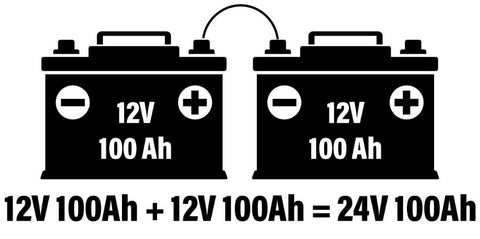A Comprehensive Guide to Wiring Batteries in Series vs Parallel

If you're looking to increase the voltage or capacity of your battery system, wiring multiple batteries together can help achieve this goal. However, it's important to understand the difference between wiring batteries in series and parallel and how each configuration affects the overall performance of your batteries.
Wiring Batteries in Series
To connect batteries in series, you link the positive end of one battery to the negative end of another.This creates a chain of batteries where the voltage of each battery is added together. For example, if you have two 12-volt batteries wired in series, the total voltage output will be 24 volts.

Wiring batteries in series is useful when you need to increase the voltage of your battery system. However, it's important to note that the capacity of the batteries remains the same. In other words, wiring batteries in series doesn't increase the amount of energy stored in the batteries; it only increases the voltage output.
Wiring Batteries in Parallel
In contrast, when you wire batteries in parallel, you connect the positive terminals of all the batteries together and the negative terminals together. This creates a bank of batteries where the capacity of each battery is added together. For example, if you have two 12-volt batteries wired in parallel, the total capacity will be double that of a single battery.

Wiring batteries in parallel is useful when you need to increase the capacity of your battery system. However, it's important to note that the voltage output remains the same. In other words, wiring batteries in parallel doesn't increase the voltage output of the batteries; it only increases the amount of energy stored in the batteries.
Wiring Batteries in Series and Parallel
You can also wire batteries in series and parallel to get the benefits of both configurations. For example, if you have four 12-volt batteries, you could wire them in two sets of two batteries in series and then wire those sets in parallel. This would give you a total voltage output of 24 volts and double the capacity of a single battery.

It's important to note that wiring batteries in series and parallel can be more complex, and it's essential to ensure that all the batteries are of the same type, age, and capacity. Failure to do so could result in uneven charging and discharging of the batteries, reducing their overall lifespan.
In conclusion, understanding how to wire batteries in series vs parallel is crucial if you want to optimize the performance of your battery system. Whether you need to increase voltage, capacity, or both, knowing the advantages and limitations of each configuration will help you make an informed decision.
Charging and Discharging Batteries in Series vs Parallel
When charging and discharging batteries, it's important to understand how the configuration affects the process. When charging batteries in series, the charging current is distributed evenly among all the batteries. However, when discharging batteries in series, the current flows through each battery sequentially, which can result in uneven discharge if the batteries are not of the same capacity.
On the other hand, when charging batteries in parallel, each battery receives the full charging current, which can lead to faster charging time. However, when discharging batteries in parallel, the load is shared equally among all the batteries, which can result in uneven discharge if the batteries are not of the same capacity.
Application of Series vs Parallel Wiring
The choice between wiring batteries in series or parallel depends on the application. For example, in a solar power system, where high voltage is required, wiring batteries in series may be the best option. In contrast, in an application that requires a lot of energy storage, such as an off-grid cabin, wiring batteries in parallel may be more appropriate.
It's also worth noting that some battery chemistries, such as lithium-ion, have different requirements for series and parallel wiring. Therefore, it's essential to consult the manufacturer's guidelines before wiring lithium-ion batteries.
Final Thoughts
Wiring batteries in series or parallel has its advantages and limitations, and it's crucial to understand how each configuration affects the overall performance of your battery system. Whether you need to increase voltage, capacity, or both, careful consideration of the application and battery type is necessary to ensure optimal performance and lifespan of your batteries.


![[Full Guide] The Comprehensive Guide to LiFePO4 Battery Life](http://www.timeusbpower.com/cdn/shop/articles/The_Comprehensive_Guide_to_LiFePO4_Battery_Life_757d2749-9468-4739-ac83-0960c27749b0.jpg?v=1722918256&width=1080)
